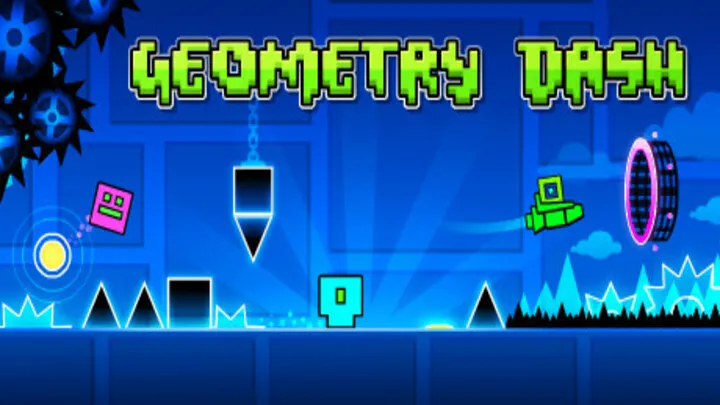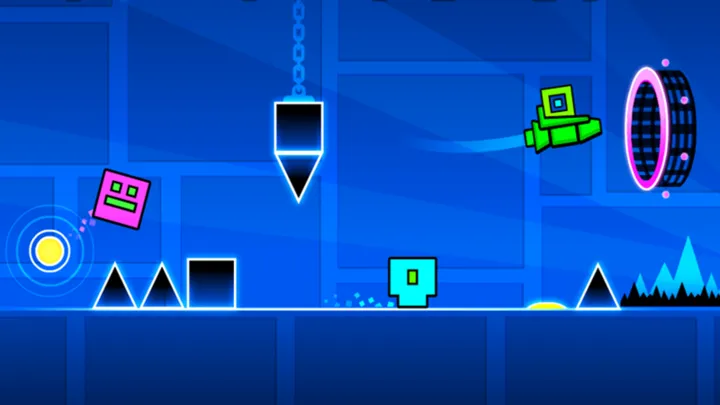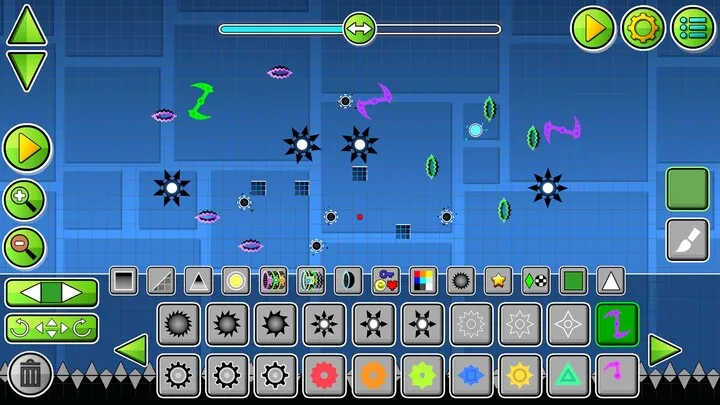Geometry Dash is more than a fast-paced rhythm platformer—it is a psychological experience rooted in timing, muscle memory, perception, and the human brain’s ability to synchronize with sound. Behind every jump, dash, or gravity flip lies a complex interplay of cognitive processes. Players are not simply reacting to obstacles; they are attuning themselves to rhythmic patterns that blend audio cues, visual stimuli, and memorized sequences. This article explores the deeper psychology that makes Geometry Dash so addictive and uniquely challenging. Through ten major sections, we break down how rhythm controls focus, how timing reinforces learning, and how cognitive flow develops across beginner to expert players.
1. Understanding Rhythmic Perception in Geometry Dash

Rhythmic perception is the foundation of Geometry Dash. While it appears to be a visual game driven by level design, the true structure underlying gameplay is music. Players quickly realize that their jumps, dashes, and flips align to the beat, which creates a form of cognitive entrainment—a psychological state where the brain syncs patterns of movement to audio rhythms.
As players listen, their motor coordination naturally attempts to match the tempo of the track. This is why Geometry Dash feels incredibly difficult when music is muted: the player loses the subtle predictive cues embedded in the song’s beat patterns. Rhythm becomes the brain’s method of predicting upcoming actions, acting as an invisible guide through obstacles.
Why Music Shapes Predictive Gameplay
The brain uses auditory cues to anticipate timing. This anticipation reduces reaction time and increases confidence during rapid obstacle sequences.
Key Benefits of Rhythm in Cognitive Performance
- Faster decision-making
- Improved timing accuracy
- Enhanced motor synchronization
2. The Role of Timing in Developing Player Skill
Timing is the second pillar of mastery in Geometry Dash. From the earliest levels to the most complex demons, gameplay success depends on the player’s ability to execute inputs within milliseconds of accuracy. This precision derives from developing an internal sense of timing—an unconscious mental clock.
Players who excel in Geometry Dash often exhibit heightened temporal awareness. They understand, even without counting, how long each block length lasts, how high their jump arc is, and how soon the next trigger will activate. This timing becomes a learned rhythm, reinforced through repetition and shaped by the tempo of the track.
Micro-Timing and Muscle Memory
Micro-timing refers to the tiny adjustments the brain makes during play. As players repeat a level, these micro-timings become automated, forming a strong foundation for consistent runs.
How Timing Evolves
- Early stage: conscious counting
- Mid stage: pattern recognition
- Late stage: automated instinct
3. Pattern Recognition and Cognitive Mapping

Pattern recognition is a crucial mechanism in Geometry Dash. The game’s levels are designed around repeating or evolving patterns—spike clusters, orb chains, portal transitions, and wave tunnels. The human brain excels at detecting these patterns, which is why players improve after repeated attempts.
Over time, a mental map forms. The brain constructs a sequence of predictions: after a blue orb comes a gravity flip, then a tight ship corridor, then a triple spike. Players rely on these mental models to achieve consistency. Even the most chaotic demon levels have logic embedded in their design, and skilled players learn to interpret this logic as a rhythm of shapes and timings.
Visual Patterns as Memory Anchors
Repeating geometric shapes serve as anchors that help players anticipate what comes next, reducing the cognitive load of real-time decision making.
Benefits of Pattern Recognition
- Faster adaptation
- Reduced reaction stress
- Improved long-term retention
4. The Flow State: Geometry Dash’s Psychological Sweet Spot
Flow state is a mental condition where players achieve perfect harmony between skill and challenge. Geometry Dash is uniquely engineered to induce flow: fast-paced action, consistent rhythmic cues, and progressive difficulty create an environment where the brain becomes fully immersed.
Once in flow, players stop consciously thinking about jumps or timings. Movements become effortless and controlled. This is the psychological zone where personal bests happen more frequently, and levels that felt impossible suddenly become achievable.
Conditions That Trigger Flow
- Clear goals
- Immediate feedback
- Balanced difficulty
- Strong rhythmic guidance
Signs You’ve Entered Flow
- Time distortion
- Reduced stress
- Automatic movement execution
5. Auditory-Motor Synchronization: Why Your Fingers Follow the Beat

One of the most remarkable psychological elements of Geometry Dash is how players’ fingers begin matching the beat subconsciously. This is known as auditory-motor synchronization. Human brains are hardwired to connect sound with movement—dancing is a natural example, but Geometry Dash applies the same principle at extreme speed.
When players listen to a song, their motor cortex activates patterns that match the rhythm. This means that even before they memorize a level, their body is already learning its temporal structure. Geometry Dash leverages this mechanism to help players adapt faster than they realize.
Rhythm as a Motor Guide
Audio cues tell players when to jump, even if their eyes haven’t processed the next block yet.
Why Muted Gameplay Feels Impossible
Removing sound increases cognitive demands by forcing players to rely entirely on visual patterns, eliminating a major source of predictive timing.
6. The Psychology of Repetition and Mastery
Repetition is often seen as frustrating in Geometry Dash, but psychologically, it is the mechanism that leads to mastery. Every failed attempt provides a micro-learning opportunity. Players adjust timing, refine recognition, and sharpen motor response with each run.
Instead of interpreting failure as loss, the brain interprets it as feedback. This transforms repetition into a powerful learning loop. Geometry Dash uses this loop to shape players into highly efficient pattern processors.
The Learning Curve
Early attempts reveal patterns; mid attempts refine timing; late attempts require discipline and anti-tilt.
Memory Consolidation Through Repetition
- Short-term learning on each run
- Long-term retention after breaks
- Enhanced performance with sleep cycles
7. Challenge, Frustration, and Emotional Regulation

Geometry Dash is emotionally intense. Players face sudden deaths, unexpected failures, and repeated setbacks. Yet many continue playing because the game satisfies a unique psychological cycle of effort and reward.
Understanding emotional regulation is essential for long-term enjoyment. Skilled players manage frustration through controlled breathing, posture adjustments, or structured breaks. This keeps the mind sharp and prevents emotional overload, which can sabotage timing and rhythm perception.
The Psychology of Near-Misses
A death at 97 percent triggers emotional spikes, but also proves that mastery is near. The brain interprets this as motivation rather than discouragement.
Regulation Techniques
- Structured pauses
- Physical relaxation
- Music reorientation
8. Cognitive Load and Information Filtering
Geometry Dash’s visual design bombards players with colors, objects, triggers, and movement. Managing cognitive load—how much information the brain processes at once—is critical for survival.
Expert players don’t look at every obstacle individually. They filter out irrelevant details and focus only on cues that matter. This selective attention dramatically improves performance.
Tunnel Vision and Focus
To achieve tunnel vision, the brain prioritizes high-value information—like orb timing and spike spacing—over background design elements.
Reducing Cognitive Overload
- Practice chunking mechanics
- Focus on rhythm instead of visuals
- Use peripheral vision training
9. Memory Techniques for Beating Difficult Levels
Memory is crucial for completing harder Geometry Dash levels. While some players rely on pure reaction, most demon-level completions involve memorized sequences. Players develop both visual memory (layout recognition) and rhythmic memory (timing patterns tied to music).
Over time, these memories become procedural—executed like a dance choreography. What begins as conscious memorization transforms into automated behavior.
Chunk-Based Memorization
Breaking a level into chunks allows the brain to store smaller, manageable sequences instead of one overwhelming chain.
Memory Reinforcement Methods
- Repetition with music
- Slow practice modes
- Identifying visual landmarks
10. The Long-Term Evolution of Rhythm and Timing Skills
Veteran Geometry Dash players demonstrate advanced perception, timing, memory, and emotional control. Their skills evolve gradually, shaped by thousands of attempts and countless hours of musical immersion.
Over time, players become able to quickly analyze unfamiliar levels. They can detect rhythmic intent, anticipate design logic, and adapt timing without extended practice. What seems complex to new players becomes second nature to veterans.
Cross-Game Skill Transfer
Geometry Dash skills often transfer to rhythm games, timing-based action games, and even music performance.
The Psychology of Continuous Improvement
Players develop:
- Higher confidence
- Faster adaptation
- Stronger rhythmic intuition
Conclusion
The psychology of rhythm and timing in Geometry Dash reveals why the game is so addictive, challenging, and rewarding. Behind every jump lies a complex interaction of sensory input, motor synchronization, cognitive mapping, pattern recognition, memory, and emotional endurance. Geometry Dash is not merely a test of reflexes—it is a celebration of the human brain’s ability to merge sound, movement, and focus into a single, exhilarating experience. Players keep returning because the game provides a unique psychological journey: a path from frustration to flow, from uncertainty to mastery, and from chaos to rhythmic harmony.

















